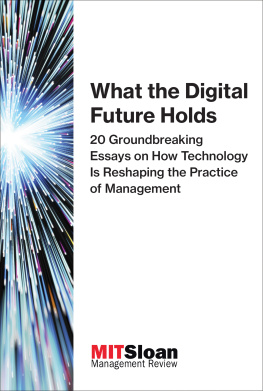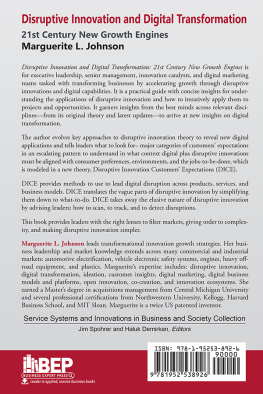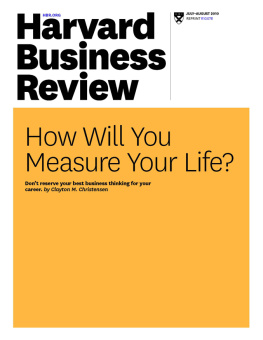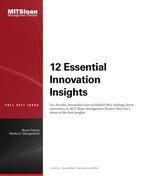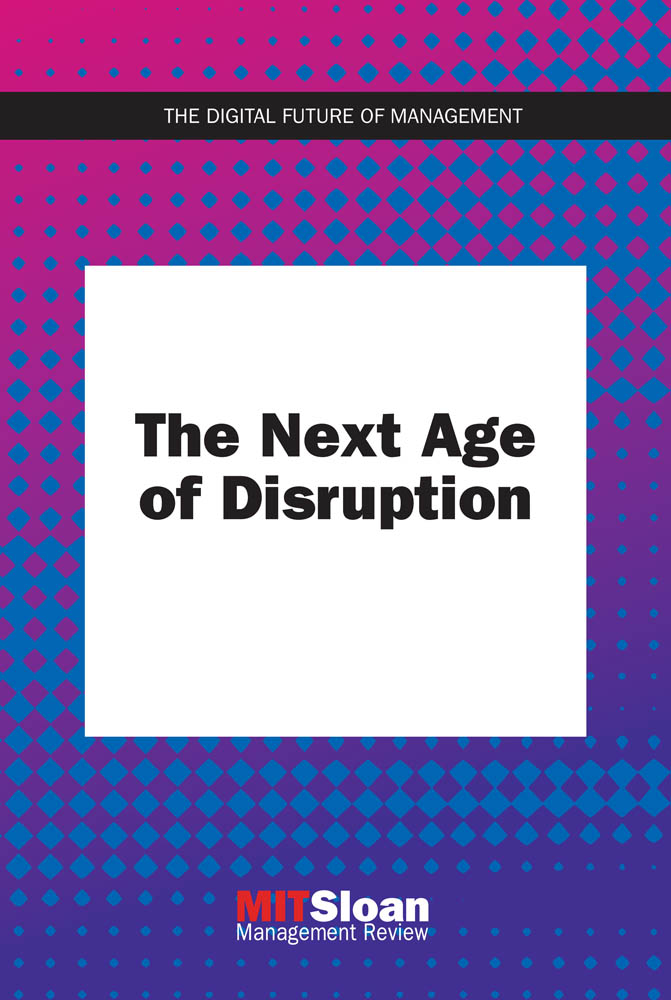
The Next Age of Disruption
The Digital Future of Management Series from MIT Sloan Management Review
Edited by Paul Michelman
How to Go Digital: Practical Wisdom to Help Drive Your Organizations Digital Transformation
What the Digital Future Holds: 20 Groundbreaking Essays on How Technology Is Reshaping the Practice of Management
When Innovation Moves at Digital Speed: Strategies and Tactics to Provoke, Sustain, and Defend Innovation in Todays Unsettled Markets
Who Wins in a Digital World? Strategies to Make Your Organization Fit for the Future
Why Humans Matter More Than Ever
How AI Is Transforming the Organization
A Managers Guide to the New World of Work: The Most Effective Strategies for Managing People, Teams, and Organizations
The Next Age of Disruption
The Next Age of Disruption
MIT Sloan Management Review

The MIT Press
Cambridge, Massachusetts
London, England
2021 Massachusetts Institute of Technology
All rights reserved. No part of this book may be reproduced in any form by any electronic or mechanical means (including photocopying, recording, or information storage and retrieval) without permission in writing from the publisher.
Library of Congress Cataloging-in-Publication Data
Names: MIT Sloan Management Review, compiler.
Title: The next age of disruption / MIT Sloan Management Review.
Description: Cambridge, Massachusetts : The MIT Press, 2021. | Series: The digital future of management | Includes bibliographical references and index.
Identifiers: LCCN 2020018951 | ISBN 9780262542210 (paperback)
Subjects: LCSH: Technological innovations. | New products. | Leadership. | Organizational change.
Classification: LCC HD45 .N458 2021 | DDC 658.4/063--dc23
LC record available at https://lccn.loc.gov/2020018951
10 9 8 7 6 5 4 3 2 1
d_r0
Contents
Karen Dillon
Clayton M. Christensen, interviewed by Karen Dillon
Scott D. Anthony and Michael Putz
Jeff Dyer, Nathan Furr, and Mike Hendron
Max Wessel and Nicole Helmer
Tucker J. Marion, Sebastian K. Fixson, and Greg Brown
Michael B. Horn
Ardine Williams, interviewed by MIT SMR
Marco Iansiti and Karim R. Lakhani
Michael A. Cusumano, David B. Yoffie, and Annabelle Gawer
Brian Halligan
Rita Gunther McGrath
Amy Webb
Rahul Kapoor and Thomas Klueter
Neil C. Thompson, Didier Bonnet, and Yun Ye
Joshua Gans
Books in the Digital Future of Management series draw from the print and web pages of MIT Sloan Management Review to deliver expert insights and sharply tuned advice on navigating the unprecedented challenges of the digital world. These books are essential reading for executives from the worlds leading source of ideas on how technology is transforming the practice of management.
Paul Michelman
Editor in chief
MIT Sloan Management Review
Karen Dillon
When Clayton M. Christensen and I first appeared at an event to discuss a book that we had coauthored, I wasnt surprised to see a crowd gathering to talk to him after we spoke. The opportunity to share an observation with or ask a question of Clay, one of the worlds truly original thinkers, was special. But I had to laugh at how often that moment turned into a request for a selfie with himClay had clearly become a rock star of management thinking. He was patient with every photo request, grateful that a new generation was interested in his ideas, and truly eager to learn how those ideas were being used and advanced.
I was honored to be asked by the editors of MIT Sloan Management Review to guest-edit this collection. Having spent the past decade working closely with Clay, Id had the chance to explore a wide range of relevant topics with him, including how the coming of AI, the rapid speed of innovation, and easy access to capital will affect how companies compete in the years aheadall topics I discussed with him and we, in turn, explore here. I started working with the team at MIT SMR before Clays death in January 2020, so I was able to sit down with him for what would be his last interview; see Disruption 2020: An Interview with Clayton M. Christensen, which follows this introduction.
Clay had continually refined his own theories over the years, but he was still wrestling with many questions, as youll see in our Q&A. He was thrilled, too, to learn how the academics and practitioners featured in this collection were thinking about some of the biggest innovation challenges looming for companies. Some of the authors here are former students or collaborators of his; others are simply people whose work Clay admired and followed. For Clay, the hunt for answerswherever they may be foundwas part of his DNA. He was more interested in getting to the right answer than in being right. And for him, getting to the right answer started with asking the right questions. So thats what we focused on in this book. The rules of competition are changingagain. Is your organization prepared for whats next?
To help you answer that question, we have broken the book into three sections, each of which addresses challenges that companies continue to encounter:
1. The human element: What role will people play in shaping or responding to disruption? Decades after Christensen first helped us understand how disruption occurs, why have companies not gotten better at solving the innovators dilemma? Scott D. Anthony (one of Clays long-time collaborators) and Michael Putz address this critical question in How Leaders Delude Themselves about Disruption. The answer, they believe, in part lies in leaders ignorance to disruption occurring in their own industry.
But even the best disruptive ideas dont always make it to market. Roadblocks emerge within companies and with potential investors long before consumers have a chance to vote. Call it the Innovators Paradox. Jeff Dyer, Nathan Furr, and Mike Hendron offer hope, exploring why good ideas get stuck and how innovators can break through skittish potential supporters concerns.
In an age of rapid innovation, are companies forgetting their obligation to protect the public trust? Predicting where your industry will stumble within this new world can make the difference in ensuring your company flourishes with its reputation intact. SAPs chief innovation officer, Max Wessel (a former student of Clays), and his colleague Nicole Helmer explore one of the most important ethical issues in an age of rapid innovation.
And in a special focus on the workforce of the future, we explore what skills tomorrows employees will need, how workforce education is itself in the process of being disrupted, and Amazons groundbreaking employee education plans. In the face of rapid technological changes like automation and artificial intelligence, helping employees keep pace is challenging. And companies are wrestling with how to retain top talenta critical differentiator in a hypercompetitive environment. Companies can no longer afford to wait for the traditional system to supply the workers they hope will help shape their futurethe need is too acute and too urgent. In three separate articles, we explore here how the workforce of the future will need to be shaped to compete.
2. The competitive element: Where will competitive advantage be gained (or lost) by understanding how new disrupters are evolving?
Next page

